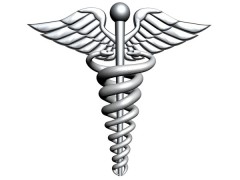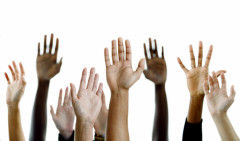Osteopathic Medicine
 About Osteopathic Medicine
About Osteopathic Medicine
You are more than just the sum of your body parts. That’s why doctors of osteopathic medicine (DOs) practice a “whole person” approach to health care. Instead of just treating specific symptoms, osteopathic physicians concentrate on treating you as a whole.
Osteopathic physicians understand how all the body’s systems are interconnected and how each one affects the others. They focus special attention on the musculoskeletal system, which reflects and influences the condition of all other body systems.
This system of bones and muscles makes up about two-thirds of the body’s mass, and a routine part of the examination DOs give patients is a careful evaluation of these important structures. DOs know that the body’s structure plays a critical role in its ability to function. They can use their eyes and hands to identify structural problems and to support the body’s natural tendency toward health and self-healing.
Osteopathic physicians also use their ears to listen to you and your health concerns. DOs help patients develop attitudes and lifestyles that don’t just fight illness but also help prevent disease. Millions of Americans prefer this concerned and compassionate care and have made DOs their physicians for life.
 The Osteopathic Approach
The Osteopathic Approach
For more than a century, osteopathic physicians have built a tradition of bringing health care to where it is needed most:
- Approximately 60% of practicing osteopathic physicians practice in the primary care specialties of family medicine, general internal medicine, pediatrics, and obstetrics and gynecology.
- Many DOs fill a critical need for physicians by practicing in rural and other medically underserved communities.
In addition, these modern-day pioneers practice on the cutting edge of medicine. DOs combine today’s medical technology with their ears to listen caringly to their patients, with their eyes to see their patients as whole persons, and with their hands to diagnose and treat patients for injury and illness.
 The DO Oath
The DO Oath
This modern version of the Hippocratic Oath for administration to osteopathic college graduates was initiated by a suggestion from Frank E. MacCracken, DO, of California to his state society. Within a year, the suggestion went from the state to the national association, and a committee was formed under the Associated Colleges of Osteopathy to prepare the text. Members of that committee included Dr. MacCracken, as chairman, and Drs. R.C. McCaughan, Walter V. Goodfellow, and Edward T. Abbott. The first version was used from 1938 until 1954, at whic h time minor amendments were adopted. This version has been in use since 1954.
 I do hereby affirm my loyalty to the profession I am about to enter. I will be mindful always of my great responsibility to preserve the health and the life of my patients, to retain their confidence and respect both as a physician and a friend who will guard their secrets with scrupulous honor and fidelity, to perform faithfully my professional duties, to employ only those recognized methods of treatment consistent with good judgment and with my skill and ability, keeping in mind always nature’s laws and the body’s inherent capacity for recovery.
I do hereby affirm my loyalty to the profession I am about to enter. I will be mindful always of my great responsibility to preserve the health and the life of my patients, to retain their confidence and respect both as a physician and a friend who will guard their secrets with scrupulous honor and fidelity, to perform faithfully my professional duties, to employ only those recognized methods of treatment consistent with good judgment and with my skill and ability, keeping in mind always nature’s laws and the body’s inherent capacity for recovery.
I will be ever vigilant in aiding in the general welfare of the community, sustaining its laws and institutions, not engaging in those practices which will in any way bring shame or discredit upon myself or my profession. I will give no drugs for deadly purposes to any person, though it be asked of me.
I will endeavor to work in accord with my colleagues in a spirit of progressive cooperation and never by word or by act cast imputations upon them or their rightful practices.
I will look with respect and esteem upon all those who have taught me my art. To my college I will be loyal and strive always for its best interests and for the interests of the students who will come after me. I will be ever alert to further the application of basic biologic truths to the healing arts and to develop the principles of osteopathy which were first enunciated by Andrew Taylor Still.
 Osteopathic Pledge of Commitment
Osteopathic Pledge of Commitment
As members of the osteopathic medical profession, in an effort to instill loyalty and strengthen the profession, we recall the tenets on which this profession is founded: the dynamic interaction of mind, body and spirit; the body’s ability to heal itself; the primary role of the musculoskeletal system; and preventive medicine as the key to maintain health. We recognize the work our predecessors have accomplished in building the profession, and we commit ourselves to continuing that work.
I pledge to:
Provide compassionate, quality care to my patients;
Partner with them to promote health;
Display integrity and professionalism throughout my career;
Advance the philosophy, practice and science of osteopathic medicine;
Continue lifelong learning;
Support my profession with loyalty in action, word and deed; and
Live each day as an example of what an osteopathic physician should be.
 DOs Around the World
DOs Around the World
Osteopathic medicine as practiced in the United States continues to gain recognition throughout the world. Osteopathic physicians, or DOs, currently have unlimited practice rights in roughly 50 countries, with partial practice rights in many more.
The American Osteopathic Association has assigned responsibility for international activities to the Council on International Osteopathic Medical Education and Affairs. The Council, which was founded in 1996, holds regular meetings in the fall and the spring with an annual report presented to the AOA House of Delegates at the annual business meeting in July.
Council activities include:
 Contact with the World Health Organization (WHO) and the Pan American Health Organization (PAHO).
Contact with the World Health Organization (WHO) and the Pan American Health Organization (PAHO).
An international seminar at the AOA’s annual convention.
Leadership in establishing an Osteopathic International Alliance.
Distribution of information on international activities.
Distribution of information about the AOA and American osteopathic medicine to interested parties outside of the U.S.
Coordination of international activity with osteopathic medical students, colleges of osteopathic medicine and interested specialty colleges.
Monitoring of licensing and registration practices in countries outside of the United States, particularly as it affects osteopathic medical education.